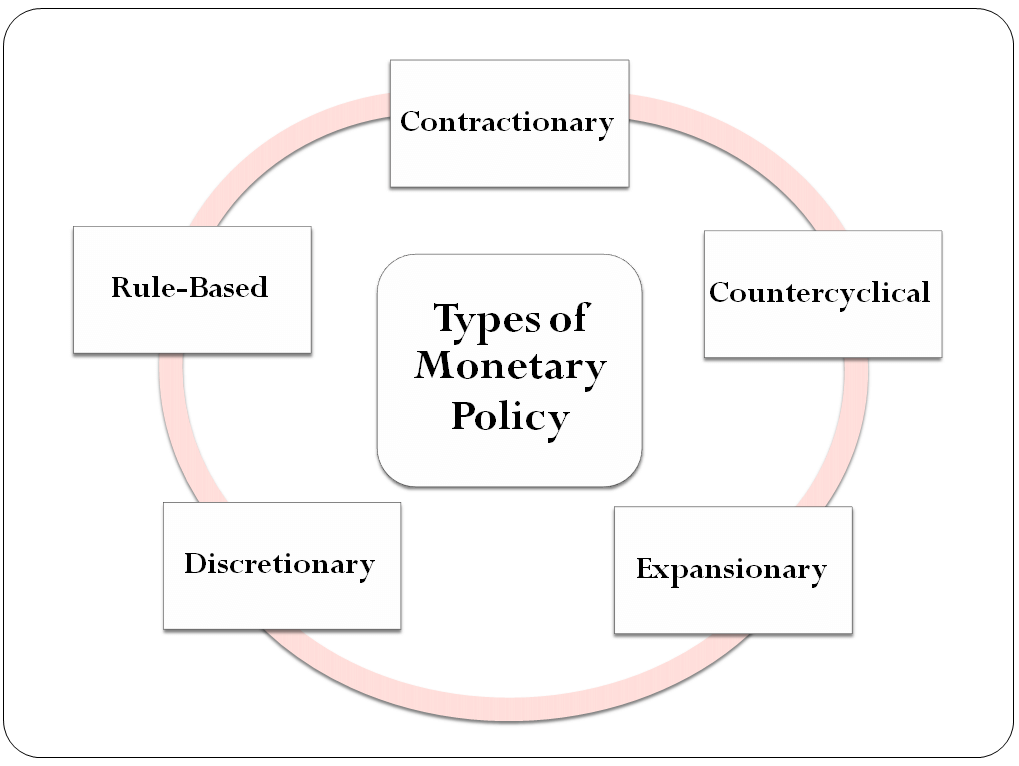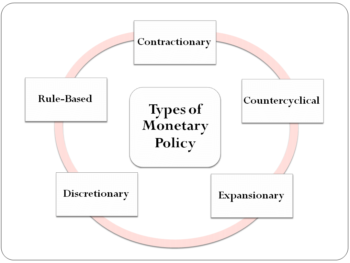Table of Content:-
- Meaning of Monetary Policy
- Definition of Monetary Policy
- Objectives of Monetary Policy
- Types of Monetary Policy
- Instruments of Monetary Policy
Meaning of Monetary Policy
Monetary policy is defined as the policy of the Central Bank, where the cost, availability and use of money are regulated through various monetary methods, to attain predetermined objectives. It uses various instruments to determine the level of aggregate demand for goods and services or to analyse the trends in the economic sectors.
Variations in the economy affect the level of economic activities and the demand and supply of credit flow. These variations occur due to the changes made in the monetary policy. In turn the economic policy changes due to varying costs and availability of credits. This change affects the asset pattern of financial institutions and commercial banks.
Definition of Monetary Policy
According to Paul Einzig, “Monetary policy is the attitude of the political authority towards the monetary system of the community under its control”.
According to Johnson, “Monetary policy is defined as policy employing central bank’s control of the supply of money as an instrument for achieving the objectives of general economic policy.”
It plays an important role in fostering the economic development of a country. Over the years, there has been wide acknowledgement and recognition of the need for monetary control. It plays an important role in not only managing the level of demand and supply of money but also controlling the functioning of credit, deposits, currency and foreign exchange within the country.
Objectives of Monetary Policy
The objectives of monetary policy in India are given as follows:
1) To Maintain Price Stability
Price instability is common for all economies. It is characterised by inflation and deflation. ‘Easy money policy’ and ‘Dear money policy’ are implemented by the financial policy of the country in response to recession and inflation, respectively. Through such policies, income and wealth inequalities are removed.
2) To Support Economic Growth
Supporting economic growth is the core objective of economic policy. Maintaining income and price stability through the country’s policy contributes to economic growth. By regulating interest rates and investment through designing economic policy, the RBI regulates the economic growth of the country.
3) To Achieve Full Employment
Another objective of this policy is to achieve a full employment level in the country. The meaning of full employment here is everybody requiring a job gets the job. It does not guarantee zero unemployment. With the help of expansionary monetary policy, it is possible to create many new jobs by increasing the credit supply.
4) To Reduce Economic Inequalities
It is also useful for attaining economic equality in the system. It focuses on designing policies for agriculture, village businesses, small-scale businesses, etc. These policies help in the equal development of such sectors of society. Therefore, the policy aims to reduce economic inequalities.
5) To Maintain Exchange Rate Stability
The ‘exchange rate’ refers to the value of the home currency in terms of any foreign currency. In case of frequent fluctuations in the exchange rate, foreign investors avoid investing in such countries. Therefore, the Reserve Bank of India regulates this exchange rate with the help of economic policy by regularly updating the foreign exchange reserves.
6) To Achieve a Balance of Payments (BOP) Equilibrium
It also focuses on achieving a balance of payment equilibrium. The money supply in the market keeps changing, i.e., increasing or decreasing. It is the objective of the RBI to regulate the money supply in the market through effective policy. Through maintaining the money supply in the market, the equilibrium of the balance of payment can be achieved.
Types of Monetary Policy
The need and importance of economic policy keep on varying according to the prevailing economic environment.

The types of monetary policy followed can be:
1) Contractionary (Tight) Monetary Policy
The prime objective of this policy is to control inflationary conditions by contracting the supply of money. Achieving this involves selling government securities, increasing policy rates, and raising the reserve requirements of the market.
2) Countercyclical Monetary Policy
This policy is the combined implementation of expansionary and contractionary monetary policy. Handling the cyclical situation can be accomplished by applying counter-cyclical measures. For example, when the economy faces inflation the contractionary monetary policy can be used while expansionary monetary policy can be applied in the situation of deflation.
3) Expansionary Monetary Policy
Expansionary monetary policy refers to the reduction of policy rates bank rate or repo rate, reserve ratio and procurement of government securities. This increases the government’s encouragement over the spending on goods and services and the expansion of credit and money supply
4) Discretionary Monetary Policy
The discretionary monetary policy, allows the Central Bank to control the monetary policy. As per their discretion, the Central Bank can evaluate and alter the rules and regulations regarding the money supply and related variables.
5) Rule-Based Monetary Policy
This policy follows certain predefined sets of laws, principles, and regulations to manage the money supply and related variables. No authority, including the Central Bank, can alter this policy. Monetary policy also becomes inactive in this rule-based policy. At certain times the economy requires a sharp increase in the money supply, while in other cases, it calls for a substantial reduction. For example, to maintain the gold standard prevailing in the market, the conduct of monetary policy should be increased a little more than the actual price of the gold at the certified par.
Instruments of Monetary Policy: Credit Control by Reserve Bank of India
Credit Control is the most significant tool of monetary policy. The instruments of credit control can be categorised into the following points:
- Quantitative methods, and
- Qualitative methods
Quantitative Instruments
There are the following quantitative instruments of credit control by RBI:
1) Variations in the Reserve Requirement
In India, it is considered one of the instruments used to control the flow of credit. The Reserve Bank of India (RBI) holds the authority to manage and control the flow of credit in the country. The RBI can create and regulate the credit flow of banks by altering the ratio. These reserve requirements can be of two types:
i) Cash Reserve Ratio (CRR)
Cash Reserve Ratio is the amount of cash reserve that commercial banks deposit with the RBI. RBI has the authority to fix the limit of CRR. The team reviews the ratio on a fortnightly average basis. The current CRR is 4 % as of Aug 2018.
ii) Statutory Liquidity Ratio (SLR)
It refers to the total of liquid assets the bank has to reserve for itself at the time of crisis. The ratio of SLR can be increased up to 40% by the RBI. At present, the SLR for the total demand and time liabilities of commercial banks is 19.5 %.
2) Bank Rate
The rate at which the central bank allows commercial banks to rediscount bills or papers and provide advances against approved securities is known as the ‘Bank Rate’. This policy is very important as it affects the cost and availability of credit in a country. The current bank rate is 6.75% as of Aug 2018.
3) Repo Rate and Reverse Repo Rate
RBI acts as a lender to commercial banks. The banks can be funds from RBI whenever in need. The rate at which a bank borrows money from RBI is known as the Repo the Current repo rate is 6.5% as of Aug 2018. If the repo rate decreases then banks can borrow money at cheaper rates. Whereas, an increase in repo rate results in higher lending rates
The reverse repo rate is the rate at which RBI borrows money from the bank. This policy is used when banks hold a substantial amount of floating money. Presently, the reverse repo rate is 6.25% as of Ang 2018.
4) Liquidity Adjustment Facility
In a liquidity adjustment facility, repurchase agreements are used to borrow money from banks. This tool helps the government to bring stability to the market and equips banks to bear liquidity pressures.
5) Open Market Operations
Open market operations are defined as the process of purchasing and selling various assets like government securities, gold, foreign exchange, shares and bonds of a company by the RBI. The regulation of the money supply is mainly applied under this policy. The whole process of inflow and outflow of money is controlled by the Central Bank. This can be implemented through interest rates or exchange rates.
Qualitative Instruments
The qualitative instruments are explained below:
1) Margin Requirement
The difference between the market value and the maximum loan value of a particular security is called the margin. By altering the marginal requirement of a loan, the flow of credit can be controlled. For example, if a person deposits their property worth 1,00.000 as a security, then he will receive a loan amount of 785,000 only from the bank. Therefore, the margin created will be 15,000, which makes the marginal requirement of 15%, Likewise, as the credit limit increases, the marginal requirement decreases.
2) Regulation of Consumer Credit
The regulation of consumer credit helps the Central Bank to prevent the market from inflation and deflation of the economy. For example, in the case of consumer durables with high prices having excess demand, the Central Bank can increase the down payment, and reduce the number of repayment instalments to reduce consumer credit. On the contrary, in case of deflation due to a deficit demand for certain commodities, the Central Bank can decrease the down payment and increase the number of repayment instalments to increase consumer credit.
3) Moral Suasion
Persuasion and request combine to form moral suasion. Central Bank uses this tool of credit control over commercial banks by way of persuasion and request. In the case of an inflationary situation, commercial banks avoid giving loans for provisional and non-essential purposes on the persuasion and request of the Central Bank. On the contrary, in dealing with deflation, commercial banks extend their credit on the approval of the Central Bank. Hence, commercial banks can successfully achieve the objectives of monetary policy with the help of the moral suasion of the Central Bank.
4) Credit Rationing
Commercial banks use this instrument to maintain and regulate the rationale for providing credit to the public. It focuses on restraining the amount of loans and advances approved by banks. Sometimes, it limits the loans and advances of a particular category. Central Banks may also use credit rationing to restrict discounts on short-term bills.
5) Direct Action
The Central Bank reserves the right to take any action against commercial banks which violate the guidelines of the Banking Regulation Act. It maintains the follow-up of guidelines and directions of the central bank.
6) Publicity
Using publicity is also an instrument for credit control. Mainly used by the RBI, it reviews prevailing market conditions and directs commercial banks to follow recommendations to control market fluctuations.
